|




|
The Thunder Child: The Mystery of the Spider Pit Sequence
An analysis by Roy P. Webber
All stills retain their copyright, shown here for reference and review
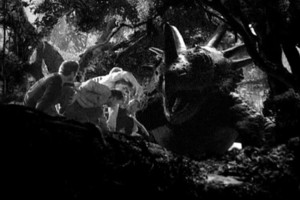 Peter Jackson's recreation of the Spider Pit
Peter Jackson's recreation of the Spider Pit |
Perhaps the most discussed facet of King Kong by fans, besides all the fan made custom t-shirts, the Spider Pit sequence has actually ever been seen by a relative handful of people. This footage existed in prints shown to preview audiences before its general release in March of 1933, so this was the only opportunity to have seen these deleted scenes. Taking place immediately after Kong shakes all the sailors off the log and drops it into the chasm, several of them actually survive the precipitous plunge but are quickly set upon by hideous creatures lurking in the murky depths. Of course, all these men end up being killed in a horrific and astonishing fashion. |
Ray Bradbury claims to have been at one of these screenings, and Forrest Ackerman corresponded with a person in the Philippines who had seen Kong with the sequence still intact.
| Producer Merian C. Cooper took the Spider Pit sequence out himself, reportedly due to the shocked reactions this celluloid inspired, but a handwritten memo clearly indicates that he felt these scenes were a diversion from the main progression of events, and thus they "stopped the story". Willis O'Brien was particularly unhappy at the loss of this footage, as he felt it was his finest stop-motion animation in the entire feature. Sadly it seems that, lacking its extremely unlikely discovery in a film vault somewhere, this tantalizing piece of cinematic history will never be viewed again. |
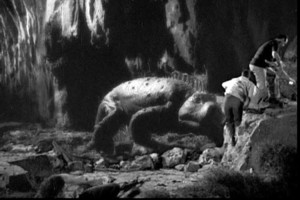 Peter Jackson's recreation of the Spider Pit Peter Jackson's recreation of the Spider Pit |
Cooper had a penchant for burning film clips which he excised from various titles, so this fact greatly dims the prospects of it turning up except for a pre-release print which may be tucked away in some obscure archive.
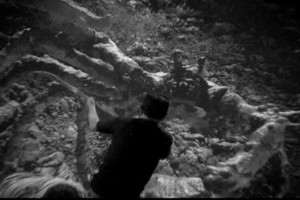
Peter Jackson's recreation of the Spider Pit |
"The Mystery of the Lost Spider Pit Sequence" runs slightly over a half-hour and starts with the footage that were cut out for the 1938 re-release, then moves to focus in on this fabled sequence. This episode then basically becomes a "behind-the-scenes" documentary on the process involved in recapitulating, to a degree as faithful as possible, what Willis O'Brien and his team crafted in the early 1930s. Spearheaded by Peter Jackson and employing the talents of the Weta team who was on the Lord of the Rings films, they commenced this undertaking by examining the few surviving stills, conceptual art, |
and the original shooting script to figure out what had been achieved for King Kong.
| Jackson is shown studying the film with the assistance of Frank Darabont (The Shawshank Redemption) and Rick Baker (1976 King Kong) to determine which shots in the release print at that point in the film match up with the script. The craftsmen of Weta are shown sculpting maquettes of the five monsters identified as being in the pit to closely match the scant photographic evidence they have before them, then making the actual stop-motion puppets. Following the time-honored methods of master modelmaker Marcel Delgado, they create some very impressive figures. |
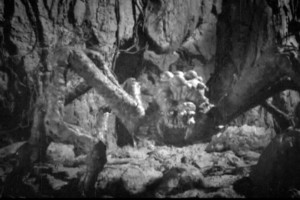
Peter Jackson's recreation of the Spider Pit |
One creature outside the spider pit is also resurrected for this project, a styracosaurus who had chased the men onto the log bridge before being shaken by the giant ape (it is seen briefly in The Son of Kong).
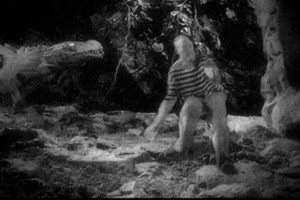 Peter Jackson's recreation of the Spider Pit Peter Jackson's recreation of the Spider Pit |
Using the original 1930s model in Jackson's possession as the guide (X-rayed to identify the armature's construction without removing the remains of the build-up materials), a reasonably faithful 1:1 scale replica is realized. Miniature sets, with the properly determined "depth of field", are made and some live-action film is shot against a blue screen. With some sound effects created for these monsters and unused "outtakes" of Max Steiner's original score, the audio content was rounded out for this new footage. Digitally degraded to match the appearance of the 1933 film and spliced in at the appropriate points, |
it is shown in its entirety at the end of "The Mystery of the Lost Spider Pit Sequence".
Running about 6 minutes, the Spider Pit sequence begins with the sailors being chased by the brontosaurus and the straggling sailor being treed and then seized in the sauropod's jaws.
| Still running through the jungle they encounter the styracosaurus (whose roar is actually Fay Wray's shriek that is slowed down to lower the pitch), who chases the men and actually chomps down on one of the party in its mouth. After Kong crosses the log bridge the men are chased onto the mighty tree trunk by the pursuing styracosaur, and are trapped in the middle after Kong sets Ann Darrow on the dead tree trunk and suddenly appears in front of them. Shaking the men off and pushing the log into the ravine, Kong roars defiantly down to the murky depths. |
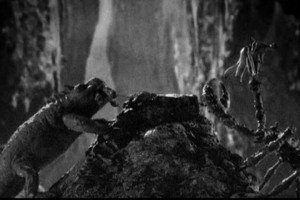
Peter Jackson's recreation of the Spider Pit |
Several men slowly get up off the muddy bottom and try to get themselves oriented with these eerie, dank surroundings, but are quickly set upon by monstrous animals coming out of the fissures. Two men encounter a hog-like lizard and seek a defensive position on a rock, fighting it and a crab-like insect with sticks as these creatures launch a fierce onslaught from below.
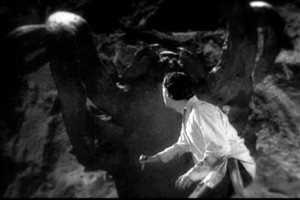
Peter Jackson's recreation of the Spider Pit |
A spider goes after and pins down another sailor, and in the background a two-legged reptile can be seen climbing a vertical wall. A fourth man is attacked by a grotesque, drooling insect with octopus-like tentacles. All of them are quickly killed and devoured in this horrifically forsaken abyss. Meanwhile Jack Driscoll is keeping Kong at bay, after having escaped the fate of the other sailors by climbing down a vine to a small recess in the cliff wall, by stabbing at the groping paw of the titanic ape. The two-legged reptile hisses and is seen working its way up towards Driscoll, who acts quickly to cut the vine supporting it. |
Plunging back to the bottom of the ravine, Driscoll now has Kong alone to worry about as the shot fades to black?
So just how "faithful" is the final product to what O'Brien and Delgado achieved in the 1930s? Looking at both the sleuthing and methodology in place to figure out and then achieve these scenes, Jackson and associates can't be faulted for the approach they took during this exercise.
| The models do look like close approximations of what would have been there, and the stop-motion animation is certainly smooth enough, but yet there isn't quite the same "feel" to this new footage as there is in the original movie. One can compare the subterranean cavern sequence in The Black Scorpion realized by O'Brien years later (animated by Pete Peterson) and see the insects move quicker here and with much less of a sense of "mass" for their gigantic size. Even the two-legged reptile scurries up the wall much faster than is seen shortly afterward in its 1933 incarnation. |
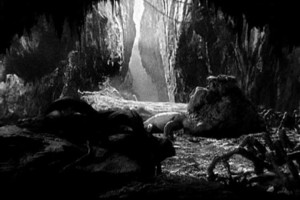
Peter Jackson's recreation of the Spider Pit |
Another point can be made about the staging of the live-action actors, who are first shown closer up than they likely would have been, and the compositing with the animation somehow just doesn't seem quite "right"King Kong.
However, this Spider Pit sequence re-creation is certainly a considerable and praise-worthy adventure in bringing something lost for decades into reality. Although it doesn't quite hit a "home run" it is certainly a fly ball to deep center field, and most viewers should be thankful the considerable task was in fact taken up. Jackson takes care to mention in "The Mystery of the Lost Spider Pit Sequence" that this new footage is only intended as a fan project and not in any way pretends to be an exact duplication. Perhaps the best thing that can be said about this respectable accomplishment is that it should serve to whets one's appetite to somehow, someday see that precious celluloid, which was unfortunately removed before theatrical release and apparently disposed of, through some miraculous find.
|
Recommended Reading

Learn more or
Buy Now

Learn more or
Buy Now

Learn more or
Buy Now

Learn more or
Buy Now

Learn more or
Buy Now

Learn more or
Buy Now
|


 Peter Jackson's recreation of the Spider Pit
Peter Jackson's recreation of the Spider Pit  Peter Jackson's recreation of the Spider Pit
Peter Jackson's recreation of the Spider Pit 

 Peter Jackson's recreation of the Spider Pit
Peter Jackson's recreation of the Spider Pit







